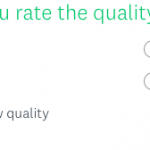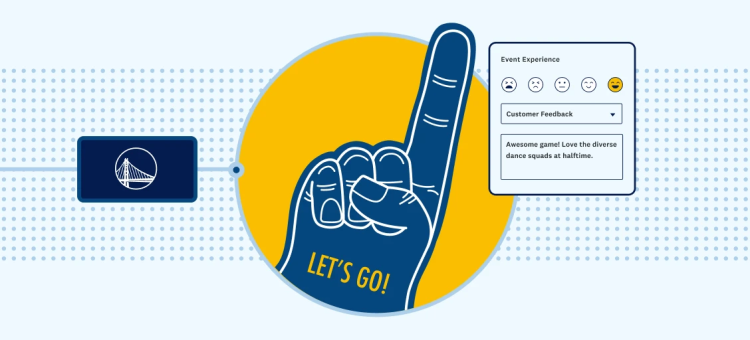Surveys are all about learning. When you first start out, you’re not just gathering data about your survey topic; you are also figuring out how different survey approaches get you closer to your goal.
There are hundreds of different things that you can tweak and experiment with in the ways that you write, send, and analyze your surveys. The more you try, the more you’ll learn about what you need to do to get the data you want, and what you can do with that data once it’s yours. Here are three cool approaches that you can try on your next survey to see if they work for you.
1. Use screening questions to get more focused results.
One of the most difficult parts of making a survey is getting the right respondents. Sometimes you don’t want to know what everyone thinks—you only care about a select group. Other times you do, but you want to consider responses from different groups separately.
Interested in what baby boomers think about Instagram? Want to see what your happy customers like about your product—or what your less-than-happy customers would like to see improved? Screening questions can help you with that.
Screening questions are questions that you can ask at the beginning of a survey to instantly understand if the person taking the survey is the person whose opinion you’re most interested in.
Here's an example of a screening question:

Say you want to hear from customers who like your product. You can qualify respondents who either select "Very high quality" or "High quality".
If you have a pro account, you can add skip logic to the question to disqualify any respondent who doesn’t select the answer you want. If you’re looking for baby boomers, make your first question “In which range of years were you born?”, followed by a series of choices. If the answer doesn’t fall in the baby boomer range, they’ll get dropped out of the survey. If you have a free account, you can still ask screening questions—you’ll just have to go through your survey responses and manually get rid of people who answered “no”.
If you’re interested in responses from different types of respondents (like millennials and baby boomers), but want to consider them separately, SurveyMonkey’s Analyze tool will let you filter different groups out.
Surveys with carefully structured screening questions can be much more targeted and much more enlightening than ones without them.
2. Try using a QR code to attract more (or different) survey takers.
If you feel like your last survey didn’t get enough attention, or that you were limited in the number of people you had access to (for example, only people you had email addresses for or only people who follow your business on social media), QR codes (scannable images that link to a website) might be your solution.
QR codes started getting a ton of attention last year, when Apple introduced easy QR scanning capabilities in iOS 11 (other phone manufacturers, most notably Motorola, do the same thing). They’ve gone from a niche techie trick to something that consumers are used to and comfortable with.
QR codes are visual and engaging, and important if you plan to promote your survey on non-digital channels. Links are helpful for sharing surveys digitally (as long as they’re clearly visible), but with QR codes, you can print out flyers, send mail campaigns, add a QR slide in a presentation, or put up a poster in your business.

Many people post QR codes on product packaging, at events, or on brochures and marketing material. Anything that is going to get in front of the eyes of your customers, employees, classmates, or the market at large is a potential vehicle for the survey QR codes.
QR codes can also be a good way to tap into a different type of audience. They’re useful for reaching people who are more protective of their privacy (and less likely to share their email addresses) and they’ve become incredibly popular in Asia, especially China where people use them constantly in services like WeChat and Alipay. This could be a good indicator of what the American consumer will want as QR codes get more mainstream.
3. Use an open-ended question and word cloud to expose new and surprising insights.
Did you feel like your last survey didn’t tell you everything you need to know? Or are you curious about what you might have overlooked? SurveyMonkey lets you ask open-ended questions so that you can get at what your respondents are really thinking, without limitation.
Sounds great, right? Open-ended questions have a ton of advantages, but they can get a little messy for a few different reasons.
- It’s hard to make charts and graphs without hard numbers.
- Open-ended questions tend to take more work for your respondents to answer.
- If there are too many, it can be difficult to understand the responses and use them effectively.
So what’s the right solution? The best thing to do is limit yourself to one or maybe two open-ended questions and ask for either a one-word answer or a one-sentence answer. That way, you’re not asking too much of your respondents, which minimizes the chance that they’ll get frustrated and stop taking the survey. It also makes it easier for you to analyze the responses.
SurveyMonkey premium accounts include text analysis and word cloud features, so that once people respond, you’ll be able to immediately isolate major trends. Word clouds can be telling, and they can also make handy visualizations that you can export and use in reports or marketing materials.
Making and using surveys is a constant exercise in applying curiosity. Testing out different strategies to is the best way to make sure that you’re getting the most out of them. Try different types of questions in your surveys, or different ways of sending them. Consider analyzing your responses with different types of filters. There’s always more to learn.
Want to try these out for yourself? Create your next survey and start testing your results now.



